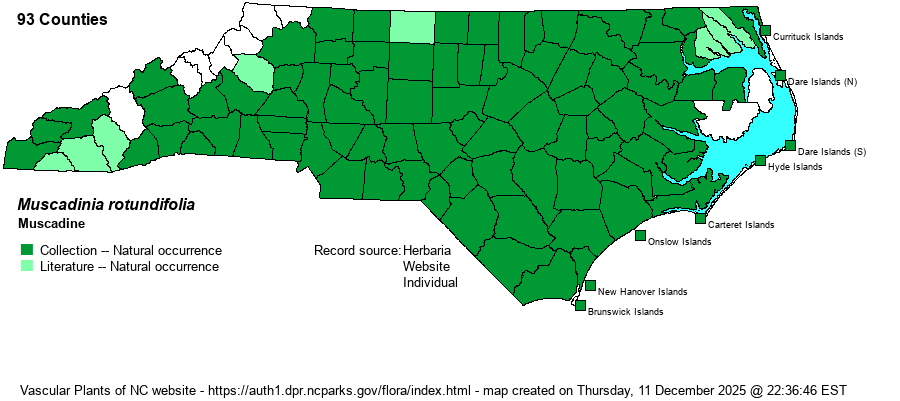| Author | (Michaux) Small | |
| Distribution | Essentially statewide, but possibly absent in a few northern Mountain counties.
This is a Southern species, ranging north only to DE and extreme southeastern MO and south to the Gulf Coast of FL and TX. Within this range, it is present in almost every county from NC west to AR and southward. | |
| Abundance | Common to abundant in the Coastal Plain and Piedmont. Uncommon in the southern Mountains, but scarce in the northern Mountains. This is one of the state's most abundant and widespread native vine species, scarce or missing only from parts of the northern Mountains. | |
| Habitat | This is the most frequently seen grape in the Coastal Plain and most of the Piedmont, being widespread in most forested and semi-forested habitats. It can occur in bottomlands, drier parts of swamps, mesic woods, upland woods, and rocky forested areas, as well. It is normally seen daily during field work east of the Mountains. Large patches can cover an acre or more of a forest floor, almost to the exclusion of other species. |
| Phenology | Blooms in May and June, and fruits from August to October. | |
| Identification | Nearly everyone knows this species, either by its leaves or by its large purple-burgundy fruit; it is quite different from other grapes. It is a deciduous, high-climbing woody vine like the others. However, all leaves are un-lobed and somewhat smaller than others, averaging only about 3 inches across. Thus, they are reasonably heart-shaped, with clearly serrated margins. Technical differences from all Vitis species include: pale lenticels (spots) visible on the bark, tendrils that are unbranched, and pith of the branches continuous through each node. It tends to have larger berries than others (along with V. labrusca), most averaging about 3/4-inch across. Note that, as with many woody vines, it typically does not flower or fruit while sprawling on the ground; it must range upward and gain height before flowering and fruiting take place. | |
| Taxonomic Comments | Recently it has been placed in a separate genus from other NC grapes – Muscadinia (i.e., Muscadinia rotundifolia); it was formerly named as Vitis rotundifolia. This is hardly a surprise, given the many differences between this species and other Vitis species. Also, Weakley (2018) and some other references list at least two varieties, though the only one in NC is the nominate one.
| |
| Other Common Name(s) | Muscadine Grape, Scuppernong. Technically, if the species were to stay in Vitis, to differentiate it from other species names, the best common name should be Muscadine Grape. If moved to Muscadinia, then the simpler Muscadine is appropriate. | |
| State Rank | S5 | |
| Global Rank | G5 | |
| State Status | | |
| US Status | | |
| USACE-agcp | | |
| USACE-emp | | |

